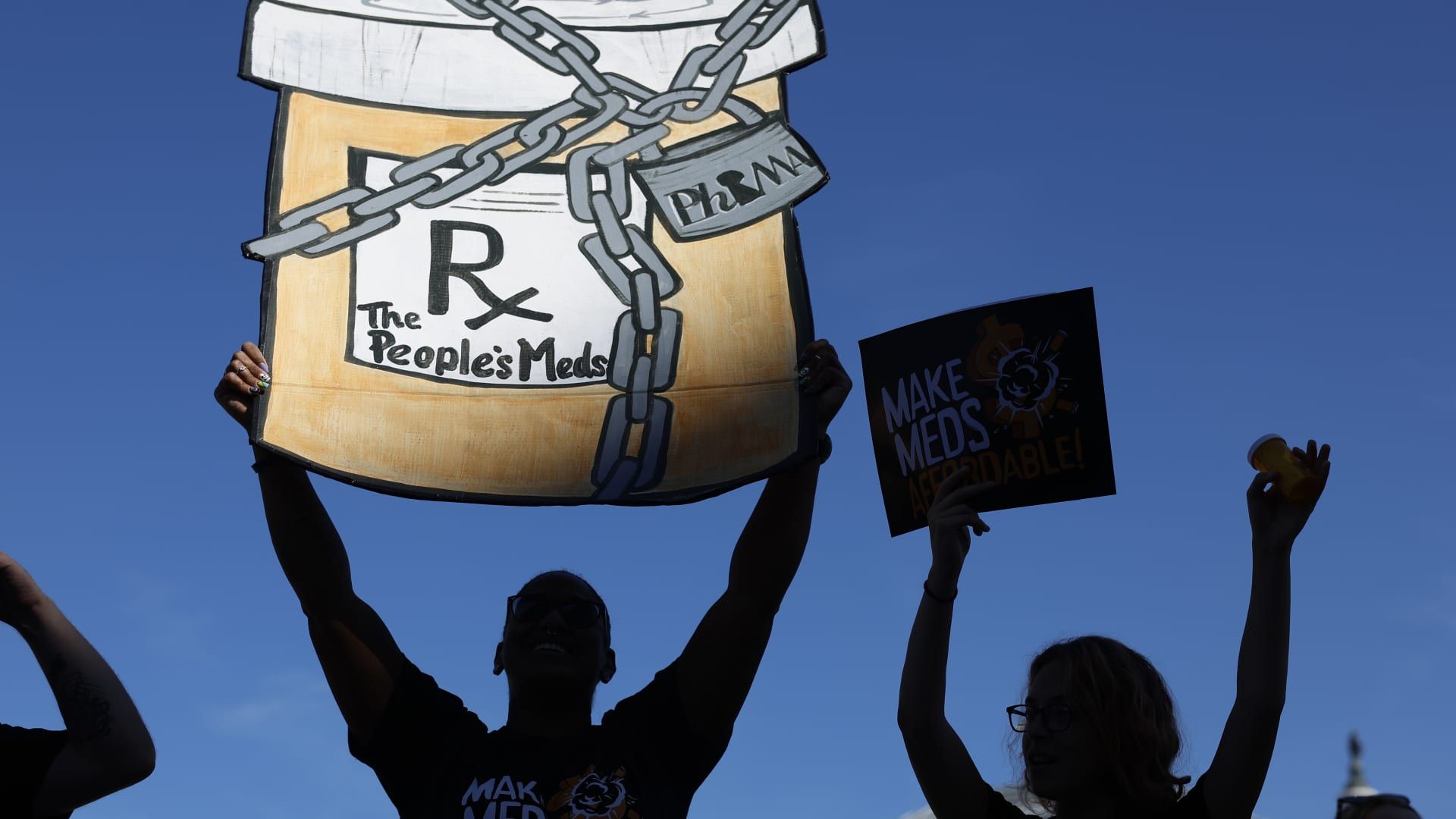Activists protest prescription drug prices in front of the U.S. Department of Health and Human Services building in Washington, DC, on October 6, 2022.
Anna Moneymaker | Getty Images
The Biden administration on Thursday will release prices for the first 10 prescription drugs that were the subject of historic negotiations between drugmakers and Medicare, a milestone in a controversial process aimed at making expensive medications more affordable for older Americans.
The government estimates that the new negotiated drug prices will result in net savings of about $6 billion for the Medicare program in 2026 alone, when they officially take effect. This is based on the estimated savings the prices would have produced. if they go into effect in 2023, senior administration officials told reporters on Wednesday.
The Biden administration also expects the new prices to save Medicare enrollees $1.5 billion in out-of-pocket costs in 2026 alone.
“For many people, being able to afford these medications will mean the difference between a debilitating illness and a full life,” Chiquita Brooks-LaSure, administrator of the Centers for Medicare and Medicaid Services, told reporters. “These negotiated prices are not just about cost. They are about helping ensure that your parent, grandparent or you can live longer and healthier.”
This comes a day before the second anniversary of President Joe Biden’s Inflation Reduction Act, which gave Medicare the power to directly negotiate drug prices with manufacturers for the first time in the federal program’s nearly 60-year history.
The administration unveiled the first set of drugs selected for price negotiations in August 2023, kicking off a nearly yearlong negotiation period that ended earlier this month.
The final prices offer pharmaceutical companies, which fiercely oppose the policy, an idea of how much they could lose in revenue in the coming years. They also set a precedent for additional rounds of Medicare drug price negotiations, set to begin in 2025 and beyond.
In a statement Thursday, President Joe Biden called the new negotiated prices a “historic milestone” made possible by the Inflation Reduction Act. He particularly highlighted Vice President Kamala Harris’s decisive vote in favor of the act in the Senate in 2022.
Harris, the Democratic presidential nominee, said in a statement that she was proud to cast that decisive vote and added that there is more work to be done to reduce health care costs for Americans.
“Today's announcement will be life-changing for many of our loved ones across the country, and we will not stop here,” Harris said in a statement Thursday, noting that additional prescription drugs will be selected for future rounds of negotiations.
These are the 10 drugs that were the subject of the initial discussions:
- Eliquis, produced by Bristol-Myers SquibbIt is used to prevent blood clotting and reduce the risk of stroke.
- Jardiance, manufactured by Boehringer Ingelheim and Eli LillyIt is used to lower blood sugar levels in people with type 2 diabetes.
- Xarelto, produced by Johnson and JohnsonIt is used to prevent blood clotting and reduce the risk of stroke.
- Januvia, made by MerckIt is used to lower blood sugar levels in people with type 2 diabetes.
- Farxiga, manufactured by AstraZenecaIt is used to treat type 2 diabetes, heart failure, and chronic kidney disease.
- Entresto, performed by NovartisIt is used to treat certain types of heart failure.
- Enbrel, manufactured by AmgenIt is used to treat autoimmune diseases such as rheumatoid arthritis.
- Imbruvica, produced by AbbVie and J&J, is used to treat different types of blood cancers.
- Stelara, made by Janssen, is used to treat autoimmune diseases such as Crohn's disease.
- Fiasp and NovoLog, insulins manufactured by New Nordisk.
The Biden administration will release a so-called maximum fair price for each drug, the highest price a Medicare Part D plan sponsor or beneficiary can pay for treatment. Medicare Part D plans, which are run by private insurers, cover prescription drugs that older Americans fill at retail pharmacies.
The lengthy negotiation process involved months of back-and-forth price offers between the companies and Medicare, which determined its initial offer for each drug using sales volume data, federal financial support for the drug's development, and data on pending or approved patent applications and exclusivity rights, among other information.
It is difficult to compare a drug's new negotiated price to its current list price, which is what a wholesaler, distributor, or other direct purchaser paid the manufacturer for a drug before any discounts.
That's because most of the 10 drugs are already subject to deep discounts after private negotiations with Medicare Part D plans. But the deeply discounted net price that Part D plans pay for a given drug is unknown because those conversations are confidential, according to Leigh Purvis, director of prescription drug policy at AARP's Public Policy Institute.
AARP, the influential lobbying group representing people over 50, has advocated for new Medicare negotiating powers.
“I think that's what people are going to be trying to figure out: Are these negotiated prices lower than the net prices that Medicare Part D was already paying?” Purvis told CNBC. “And that's the comparison that people are looking for. Now, recognizing that the rebates are confidential, that's going to be a difficult question.”
A senior administration official confirmed that a direct comparison between negotiated prices and net prices paid by Medicare is “commercially sensitive information.”
“Each Medicare Part D plan has its own individual reimbursement arrangements, and Medicare is prohibited from sharing any information we have there,” the official told reporters.
The negotiations are the centerpiece of the Biden administration’s efforts to rein in rising drug costs in the United States. Some congressional Democrats and consumer advocates have long pushed for the change as many seniors across the country struggle to afford care.
The price negotiations are expected to save money for Medicare enrollees, who take an average of four to five prescription drugs a month.
Nearly 10% of Medicare enrollees age 65 and older, and 20% of those under 65, report difficulty affording their drugs, a senior administration official told reporters last year.
President Joe Biden signs the Inflation Reduction Act of 2022 at the White House on August 16, 2022.
Mandel Ngan | afp | Getty Images
But the pharmaceutical industry sees the process as a threat to revenue growth, profits and drug innovation. Several drug companies and trade groups filed lawsuits last year seeking to derail the negotiations and declare them unconstitutional.
The lawsuits filed by Merck and Novartis against the price negotiations are awaiting a decision by the district courts. In each case, the lawsuits overlap with those filed by Novo Nordisk, AstraZeneca, Boehringer Ingelheim, Bristol Myers Squibb and J&J that have been rejected in recent months.
The 10 drugs are among the 50 highest cost-sharing drugs under Medicare Part D.
According to CMS, the 10 drugs accounted for $50.5 billion, or about 20%, of total Part D prescription drug costs from June 1, 2022, through May 31, 2023. In 2022, 9 million seniors spent $3.4 billion out-of-pocket on the 10 drugs, with some paying more than $6,000 a year for just one of the drugs on the list, according to the Biden administration.
Drugs have been on the market for at least seven years without generic competitors, or 11 years in the case of biological products such as vaccines.
Medicare covers about 66 million people in the U.S., and 50.5 million patients are enrolled in Part D plans, according to 2023 data from health policy research organization KFF.
What happens next?
CMS has until March of next year to publish an explanation of the negotiated prices for each drug. Those new prices will go into effect on January 1, 2026.
By February 2025, the Biden administration will also reveal up to 15 more drugs that will be subject to the next round of price negotiations, with agreed-upon prices taking effect in 2027. Drugmakers will have until the end of that month to decide whether to participate in the program.
After that second round, CMS can negotiate prices for 15 more drugs that will take effect in 2028. The number increases to 20 negotiated drugs per year beginning in 2029.
“Sometimes I think people get hung up on the fact that their drug isn't on the list, but it will be on the list at some point in the future if they're on a drug that's generating high costs,” Purvis said.
CMS will only select Medicare Part D drugs for covered drugs in the first two years of negotiations. It will add more Medicare Part B-covered specialty drugs, which are typically administered by physicians, in 2028.
Notably, Harris would likely seek to expand the scope of negotiations if elected president, experts told CNBC.
Purvis stressed that Medicare is “only going to get better at this process as we move forward.”
“We expect taxpayers to begin saving billions of dollars as this negotiation program gets underway and Medicare improves the drug negotiation process,” he told CNBC.










